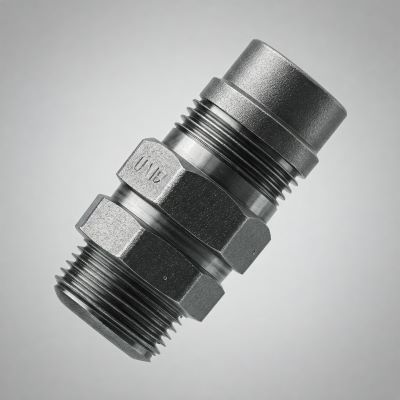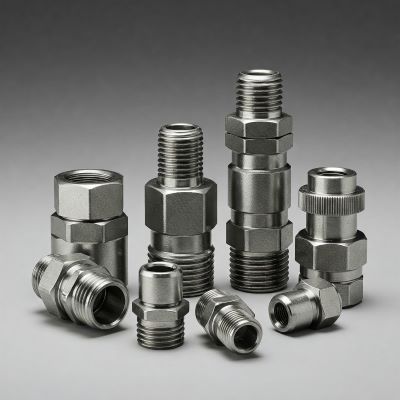Threaded fasteners and fittings are essential components in countless mechanical and plumbing applications. They provide a reliable way to join parts together, whether it’s securing bolts on a car engine or connecting pipes in your home’s plumbing system.
Two common thread types you’ll encounter are UNF (Unified National Fine) and NPT (National Pipe Thread). While they might seem similar at first glance, mixing these two can lead to serious problems.
This guide explains why and offers best practices to avoid costly mistakes.
Understanding UNF and NPT Threads
What is UNF (Unified National Fine)?
UNF threads are a type of straight (parallel) thread with a fine pitch (meaning there are more threads per inch). They are commonly used in applications requiring precise fastening, such as in the automotive, aerospace, and machinery industries. UNF threads are designed primarily for holding parts together securely, not for creating a fluid-tight seal.
What is NPT (National Pipe Thread)?
NPT threads, on the other hand, are tapered threads. This taper is crucial because it’s what allows NPT fittings to create a tight seal. NPT threads are the standard for fluid and gas piping and are widely used in plumbing, hydraulic, and pneumatic systems. They are designed specifically for sealing, preventing leaks in systems carrying liquids or gases.
Key Differences Between UNF and NPT Threads
Here’s the table to tell the difference between UNF and NPT threads:
|
Feature |
UNF (Unified National Fine) |
NPT (National Pipe Thread) |
|
Thread Shape |
Straight (parallel) |
Tapered |
|
Purpose |
Fastening |
Sealing |
|
Common Usage |
Bolts, nuts, machinery, automotive |
Plumbing, gas, fluid piping |
|
Sealing Method |
Requires washers or gaskets |
Creates a mechanical seal (with sealant or tape) |
|
Compatibility |
Not interchangeable with NPT |
Not interchangeable with UNF |
Why You Shouldn’t Mix UNF and NPT Threads
Mixing UNF and NPT threads is a recipe for disaster. Here’s why:
1. Poor Fit & Connection Issues
The fundamental difference in thread shape – straight versus tapered – makes these two types incompatible. Trying to force a UNF fitting into an NPT port (or vice-versa) will result in a poor, often cross-threaded, connection.
2. Risk of Leaks & System Failure
NPT threads rely on the taper to create a seal. UNF threads, being straight, cannot provide this sealing action. Mixing them will almost certainly lead to leaks, especially in pressurized systems.
3. Potential for Thread Damage
The mismatch between thread types can easily strip or damage the threads on both the fitting and the port. Damaged threads mean expensive repairs or even the need to replace entire components.
4. Safety Hazards in Pressurized Systems
In hydraulic or gas systems, leaks caused by improper thread connections can be extremely dangerous. They can lead to equipment failure, fire hazards, or even explosions in extreme cases.
Best Practices to Avoid Mixing UNF and NPT Threads
1. Identify the Thread Type Before Installation:
Before you start any project, take the time to identify the thread type of each fitting and port. Use thread gauges or reference charts to confirm specifications. Check manufacturer markings; they usually indicate the thread type.
2. Use the Correct Fittings & Adapters:
If you absolutely need to connect a UNF component to an NPT component, use appropriate adapters. These adapters are specifically designed to bridge the gap between the two thread types and ensure a secure, leak-proof connection. Never try to force a direct connection.
3. Follow Industry Standards & Guidelines:
Adhere to standards set by organizations like ASME (American Society of Mechanical Engineers) and ANSI (American National Standards Institute). These standards provide guidelines for proper thread usage and installation. Always consult technical documentation for compatibility information.
4. Perform Proper Testing & Inspection:
After installation, particularly in pressurized systems, thoroughly test and inspect the connections for leaks or mechanical weaknesses. Use thread sealants or Teflon tape where necessary on NPT connections to enhance the seal.
Conclusion
Mixing UNF and NPT threads is a serious mistake that can lead to a range of problems, from simple leaks to catastrophic system failures. Always double-check thread types before installation. Using the correct fittings and adapters is crucial, especially when working with pressurized systems. When in doubt, consult technical specifications or a qualified professional to prevent costly and potentially dangerous issues.
Before your next project, take a moment to inspect your fittings. A few seconds of checking can save you time, money, and potentially even prevent accidents. Don’t let a simple thread mismatch turn into a major headache!
Post time: Jan-30-2025



